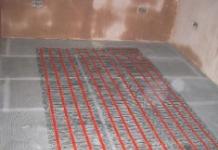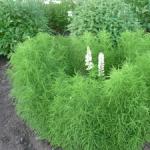Greens grown by caring housewives in the garden are a real vitamin storehouse. It serves as an excellent addition to salads, it is appropriate as a decoration for festive treats and familiar dishes.
The plant is successfully used in their recipes by cooks and folk healers. In the warm season, it is very easy to get fresh herbs, but in winter, the housewives often face the question of how to grow lettuce on the windowsill.
In fact, there are no problems with growing a plant at home. In order for households to enjoy a fresh salad every day, you do not need to make significant efforts or invest any financial resources in it.
What salad variety to grow on the windowsill
Batavia- the most unpretentious type of salad. This disruptive variety is a frequent guest on store shelves.
The obvious advantages of Batavia are endurance to high temperatures and lack of moisture, low need for additional lighting, and the possibility of growing in hydroponics.
Watercress is ideal for home gardens. This variety is moisture-loving, but in order to avoid rotting of the roots, do not overmoisten the soil when watering.
The best varieties of watercress for a home window sill or balcony are:
- broad-leaved
- Ordinary
- Curly
- peppery
Feel good on the window and precocious species, including:
- Odessa
- lollo bionda
- red creed
How to plant watercress
 A small root system of plants allows the use of shallow plastic pots up to two liters for planting.
A small root system of plants allows the use of shallow plastic pots up to two liters for planting.
Clay containers are less preferred as they tend to absorb moisture causing the soil substrate to dry out quickly.
In the absence of suitable containers for growing greens, use a regular plastic bag. Place it on any dish and fill with moist soil. On the sides of the bag, make many small holes to drain excess water. Lettuce grown in such conditions is no different from fellows from a plastic pot.
Before planting, keep the seeds in a container with a light potassium permanganate solution for three hours.
To grow watercress, the soil can be purchased at a specialty store or you can make your own. To prepare the substrate, you will need biohumus and coconut fiber, which are mixed in proportions of 1: 2.
To ensure a normal flow of air to the roots of plants and prevent stagnation of moisture, be sure to place drainage in the form of broken bricks, expanded clay, pieces of foam or pebbles under the soil layer.
Prepared seeds are planted in moist soil at a depth of ten millimeters. A container with future plants is covered with cellophane film to form a mini greenhouse.
Watercress will take less than a week to show its first sprouts. For this reason, it is considered the fastest growing herb.
After the first shoots appear, the pot must be freed from the film. Further care of the greenery growing on the balcony or window will not require much effort.
Successful cultivation of lettuce on the windowsill involves regularly moistening the soil and young leaves with a spray bottle. Spray the plant daily with settled water until it is finally strengthened.
For watering, use a watering can with a long spout. It is especially convenient to use such a device with grown foliage.
Lighting for watercress
Due to the low need for additional lighting, lettuce can be grown on a north or northwest window sill. However, he still needs some lighting.
In the cold period, the grown lettuce must be illuminated with special fitolamps or fluorescent lamps, which will provide greenery with additional light.
Install the device at a height of half a meter from the plants. Make sure that the daylight hours of the salad do not exceed fourteen hours.
So that artificial lighting does not require significant financial costs, use LED lamps. Due to the absence of heat emissions, they will not dry out the salad. Place such light sources about five centimeters from the plants.
Temperature regime
Elevated room temperature can do a disservice and lead to soil drought. Under such conditions, lettuce leaves will thicken and acquire a bitter taste. When growing a plant, create normal climatic conditions in the room.
The ideal temperature for the development of young shoots is from 17 to 20 degrees.
 Thin out young plants regularly. Perform this procedure for the first time a week after germination. The distance between the shoots should not exceed two centimeters.
Thin out young plants regularly. Perform this procedure for the first time a week after germination. The distance between the shoots should not exceed two centimeters.
The second thinning is done when several leaves are formed. This time, create gaps of at least five centimeters.
Cramped conditions cause greens to grow upwards, leading to weakening and death.
Fertilizer and pests
Lettuce growth should be accompanied by regular fertilization of the soil. As a complex composition, use an ordinary diluted mullein, which water the plants every week.
Remember that watercress, even on a home windowsill, can be attacked by harmful insects. The impact of lettuce aphids eating the roots leads to stunting and wilting of the shoots.
For successful pest control, ditch the chemicals in favor of an infusion of dandelion leaves or onion husks.
Shredded lettuce leaves wrapped in cellophane can be stored in the refrigerator for up to seven days. If you try to save the greens in a warm room, it will wither very quickly.
Before storing in the cold, the plant must not be washed, as this will lead to its inevitable wilting.
After a breakdown, the greens must be immediately eaten.
To enjoy lettuce all year round, plant it at five-day intervals. In this case, the harvest will not keep you waiting.
There are a great many types of salads, but many varieties are especially revered in the cuisines of the world. Watercress is one of the most popular, as it combines many positive properties, from the unique taste and aroma to the simplicity of agricultural technology. Moreover, it should be noted that watercress, which is often grown outdoors, grows well at home, even on the windowsill of an ordinary city apartment.
The plant is considered one of the most unpretentious, and to such an extent that in order to grow it at home, you do not have to prepare any specific soil or look for any specific varieties. Even more than that, it is best to experiment with several varieties and settle on a more suitable one. With soil, everything is much simpler, and so much so that some experienced gardeners plant lettuce seeds with other crops, for example, growing, or with moisture-loving home flowers.

You can grow greens at home in any container up to 50 mm high.
To prepare for planting, you need to decide exactly how the salad will grow, since there are several options for planting:
- in the soil mixture;
- in a cotton-gauze base;
- in a combination base.
In the first case, for growing lettuce at home, you can take any soil that is fertile or that you can get. But keep in mind that specialized soil mix from the store will be the most suitable, the least - the earth that you dug up next to the road or in the playground. In principle, you can compromise and take the soil from your garden plot, after removing all the weeds from it.
In the second case, cotton wool wrapped in gauze is used as the base. Naturally, both cotton wool and gauze should be from a pharmacy, and the density of the latter should be sufficient for long-term use.
Video about growing cress at home
The third case implies a kind of “layer cake”, which includes (from bottom to top) drainage in the form of a sand-gravel mixture, a cotton-gauze layer, and a fertile soil mixture. Drainage is necessary to remove excess water, the cotton-gauze layer will retain the required amount of moisture, and the soil will provide the plant with microelements. It is the combined method that is suitable for those who have no experience at all in growing plants either on the windowsill or in the garden, since they will practically not give a chance to ruin the greens.
You can grow greens at home in any container up to 50 mm high, since the base layer does not exceed 30-40 mm. However, it is worth remembering that a height of 40 mm is required for a combined base, and 30 mm will be enough for a cotton-gauze base. This is due to the fact that the plant itself is small, and its root system is quite compact.
Planting seeds of watercress at home is carried out by seeds immediately in the base, without any pre-treatment. However, the landing method varies somewhat depending on the top filling. For a combination or soil base, simply scatter the seeds and cover them lightly with soil. But if the base is cotton-gauze, then the seeds are scattered only over the cotton wool, and only then they are covered with gauze on top. It is believed that even in this case it is necessary to cover the seeds with nutrient soil, but this will not bring practical benefits.
Before planting, the base is watered abundantly. Immediately after disembarkation, it is sprayed from a spray bottle. In no case should you water with a stream, since a stream of water can wash out the newly planted seeds. It is also important to keep in mind that you do not need to make the seeds "float". The base must be damp, but not overflowing.

Immediately after disembarkation, it is sprayed from a spray bottle
After planting has been carried out, the watercress container is removed to a shaded cool (6-8 degrees Celsius) place, as this, on the one hand, will prevent excessive evaporation of moisture and, on the other hand, will not cause seed rotting or the appearance of fungal infections. , mildew.
It is especially important to observe the temperature regime at home if the soil was taken on a personal plot, or the landing is made in a cotton-gauze base.
The temperature rises to room temperature only when the first leaves appear. However, you should not put a container on the battery either, it is best to maintain the mode within +15 ... +18 gr. Celsius.
Video on how to sow seeds and grow them
plant care
To grow delicious greens, having created, you need to take care of it, which comes down to a few simple rules.
- Watering
Watering should be regular and plentiful, as the plant is moisture-loving and does not tolerate the lack of water. Perhaps a failure in watering is one of the few things that can instantly destroy a culture. Watering is best from a spray bottle, washing the foliage - then the greens will be especially tender and fragrant. Constant humidity in the room will also be important, because when it fluctuates, the foliage may begin to taste bitter, or even inflorescences will form.
- Light mode
Watercress loves shady areas, but that doesn't mean it doesn't need light. It is best to grow it on a windowsill or in a loggia on the north side, hiding the plant from direct sunlight, which is detrimental to foliage. In winter or during the polar night, you can replace natural lighting with any artificial one, and even LED strips with a warm glow temperature will do. It is also important to remember that the source of additional illumination should be moved away from the plant by 300-400 mm to prevent thermal damage to the leaves. In no case should you use halogen lamps, as they can burn the plant. The container should be constantly tucked up so that growth does not go into stretching the stems, but into straightening the foliage.
- Temperature
Watercress does not tolerate heat very well. Therefore, in summer it is allowed to grow it on windowsills facing the north side, and in winter - away from heating appliances and batteries. The minimum suitable temperature will be +15 degrees Celsius, the maximum - +20 degrees Celsius, the optimal one - +18.
Video about growing lettuce on the windowsill
Harvesting
The crop is harvested immediately before use, in small portions, since watercress is practically not stored - it quickly withers, loses its taste. It must be cut off with ordinary scissors, and no later than a week after the foliage appears. This is due to the fact that the greens begin to quickly lose their taste, it becomes rough and can even give bitterness. When harvesting, only leaves with a minimum stem length can be cut, since the latter has practically no taste or aroma.
Video about the garden on the windowsill
In order for the crop to be regularly available, you can pick up a salad by variety, or sow it once a week. If you choose planting by variety, you can choose the following combination:
- flagman variety. Reaches maturity in 12-17 days from the moment of germination;
- cultivar Piquant. Reaches economic suitability in 15-20 days from shoots;
- Fun variety. Technically mature in 20-30 days after germination;
- variety Accord. Ready for use in 25-35 days from the moment of germination;
- Dukat variety. Grows in 18 days from the moment of emergence of shoots.
For constant overseeding, especially in winter, the Temp variety is ideal, which reaches technical maturity in 18-23 days.
Watercress is a grass-like plant that grows quickly, requires little care, and is packed with beneficial vitamins and minerals. But in winter, our body needs useful substances so much! And if so, then why not start growing watercress on the windowsill right now, so that with the onset of frost it can be eaten?
The easiest way to grow watercress
The cultivation of any plant begins with the purchase of its seeds. But when buying seeds, you should always be extra careful so that you do not then find at home that they are completely unprepared for sowing. Therefore, when buying, you need to pay close attention to the shelf life of the seeds and make sure that it is at least six months. And then you need to start considering the package, which in no case should be wrinkled, torn or stained, because this means that the package with the seeds was already soaked through before, which means the seeds in it are completely unsuitable for sowing.
If the packaging is safe and sound, then now you can start thinking about how to plant watercress. The easiest way is to take cotton wool, wet wipes, paper towels or even a blotter, and then put them in any dish with a layer of 2 cm. The next step is to take the settled water that flows from the tap in the apartment and lightly soak that material with it on which we will grow our useful plant.

Having prepared the container for planting seeds, you should take any other container, pour watercress seeds into it, and fill them with water. After waiting a minute until the seeds swell a little in water, you need to pour it into a container we prepared in advance. And you need to do this very carefully so that the seeds lie evenly in one row. Now it remains only to tightly cover the container with the seeds with cellophane or cling film, and then put the watercress on the windowsill, where sunlight does not reach and where it is not very warm.
As soon as 24 hours have elapsed, the first sprouts will hatch from the seeds and at the same hour, you need to remove the film and start caring for them, watering very often, because watercress will not last long without water, spraying from all sides and at least once a day turning the lettuce container 180 degrees so that the stems of our plant do not lean to one side. This should be done within 2 weeks, after which the salad will grow by 7 cm and it will already be possible to cut and eat it, putting it in hot dishes or salads.

Growing watercress on soil
If you do not want to spend cotton wool, napkins or towels on growing watercress on the windowsill, then you can follow the traditional path and grow tasty and healthy greens on the ground. True, for these purposes it will be necessary to purchase a low flower pot with a hole in the bottom, where excess water will drain as necessary, a package of expanded clay drainage and soil, which will include biohumus.

The first step is to soak the watercress seeds in any vessel in a small amount of settled tap water. While the lettuce is soaking, the bottom of the pot should be covered with drainage 2 cm thick, and soil should be laid out on it with a layer of 3 cm. It remains only to pour a centimeter layer of soil on the seeds, water them lightly and also cover with cellophane or cling film. Now the planting of watercress is completed, and the pot of seeds can be placed in a dark and cool place with an air temperature of 7 degrees.
After a day, the film will need to be removed and watered again with watercress. And as soon as the first light green leaves hatch through the soil, it will be necessary to slightly thin out the plants so that there is at least a small distance of a couple of centimeters between them. Then the pot can be moved to a warmer place with a temperature of 10-15 degrees and start caring for watercress. Moreover, it is very simple to do this - you just need to regularly ventilate the room with the plant, water it and loosen the soil in the pot when it is compacted in it after watering. After 2 weeks, the salad can already be cut and consumed for its intended purpose.
It will also be helpful for you to know
Watercress or bed bug (lat. Lepidium sativum) is an edible annual, biennial plant of the Cabbage family. Originally from Iran, found in Africa, Asia. Cultural cultivation of watercress began in ancient Rome, Egypt and Greece. It has a pleasant bitter-tart (similar to radish) taste. It is used fresh as a seasoning for fish, meat, gravies, soups, omelettes, as a pleasant addition to salads.
The benefits of watercress
- It has a rich composition of useful substances: mineral salts, B vitamins, thiamine, rutin, carotene, mustard essential oil (gives a specific taste and aroma).
- The use of watercress improves digestion, increases appetite, lowers blood pressure, normalizes sleep, has a diuretic and antimicrobial effect, strengthens the immune system in general (this is especially important in winter).
- Due to its low calorie content, it is a dietary product.
Watercress at room conditions does not require significant effort, children are happy to take a great interest in this process. You can cultivate it all year round, allocating a place on the windowsill or glazed balcony. Fast growth rates and unpretentious care make watercress one of the best crops for the "home garden".
Preparing a container for growing watercress
For watercress, choose a clear plastic container with a lid, any food container will do.
You can use a shallow dish filled with seedling substrate, sawdust, foam rubber, or cotton wool as a substrate.
Cress lettuce is grown:
- In the usual way, in the ground
- Without land (there are many variations, more on that below).
How to plant watercress on a windowsill without soil
How to grow watercress on a windowsill? To get juicy healthy greens, first of all you need seed. Seeds are purchased at specialized points of sale. The packaging is usually large - the seeds will last for a long time even with frequent sowing.
How to sow

It is done in a simple way:
- Seeds should be spread on the bottom of the container, keeping a small distance of 2-3 mm, so that the plants have room to germinate.
- For 1 m² of area, 5-8 g of seeds are consumed. Spray with a fine mist sprayer.
- To germinate seeds, cover the container with a transparent lid, literally in a day sprouts will appear.
- Monitor the humidity level inside the container, if necessary (1 race in 1-2 days) spray from the spray bottle and close again.
- When the plants have risen well, the lid can be removed.
To harvest regularly, sow at intervals of 7-14 days.
Growing watercress on a paper napkin video:
An interesting way to grow watercress through a sieve
There is a rather unconventional way of watercress - through a sieve. You won't have to mess with the soil and take care of watering, the only drawback will be a reduced yield.
You will need a cup (mug) and a tea strainer. Pour the seeds evenly into a strainer and place in a mug of water. Seeds will germinate quickly - roots will appear after 5-6 days.
On sale you can find special trays for growing watercress on the windowsill.
Watercress on a windowsill with no soil? We look at the video:
It turns out that watercress can grow even without a paper backing, just in water. The method is interesting in that you can eat the whole plant from root to top, everything is very healthy and tasty!
How to care for watercress
Lighting
In the first few days after germination, provide diffused lighting. Watercress is rather shade-loving, it can even be grown in a kitchen cabinet (so pets do not harm the plant). Protect from direct sunlight, especially young sprouts.
Air temperature
High temperatures are unfavorable for the plant: place away from heating systems. Maintain the air temperature within 15-20 ° C, the optimum mark is 18 ° C.
How to water
It is best to spray from a fine sprayer to wash the leaves as well (they will be more tender and fragrant). Spray the crops from the spray gun with a few clicks 1 time per day or two, controlling the level of humidity: the container should always be damp. From a lack of moisture, the stems are stretched, and taste qualities are also lost (leaves turn yellow and acquire an unnecessarily bitter taste). The worst outcome is leaf fall.
Watercress growing on cotton wool look at the video:
Harvesting
After 2-3 weeks of cultivation, the sprouts will reach a height of 10-12 cm, you can harvest. Cut with a sharp knife or scissors as much as you need for eating at one time. The leaves quickly wither, taste qualities are lost, so they should not be stored.
Diseases and pests
Watercress has a fast growth rate, so it is not afraid of diseases and pests.
The only problem may be a black leg or rot. The way out of this situation is to re-sow, fortunately, the new crop will not have to wait long.
Application in cooking
Watercress will be an appropriate addition to many dishes. It goes well with both meat and fish, is used to make gravies, sauces, soups, vegetable soufflés, as a seasoning for cold appetizers and second courses. The leaves are added to salads, blanched, cooked with oil dressings, sugar and wine. Watercress is added to stews, omelettes, cottage cheese casseroles, decorate sandwiches - beauty and benefits.
Application in traditional medicine
The juice of the plant is used for diseases of the respiratory tract: they gargle with it, drink it when coughing; it is also used for anemia. The roots and aerial parts are used for fever, as an antiscorbutic (due to the high content of ascorbic acid), the seeds are crushed into powder and used as mustard plasters.
Varieties of watercress
Watercress varieties practically do not differ in external data: the color of the leaves is mostly green, there are varieties with a purple tint.
We classify by maturity:
- Flagship - reaches maturity within 12-18 days after emergence.
- Piquant - you can harvest after 15-20 days.
- Dukat - the ripening period is 18-20 days.
- Temp is a very popular seed variety that matures in 18-23 days.
- Fun - you can enjoy spicy greens after 20-30 days of growth.
- Accord - terms of technical maturity are 25-35 days.
- Ducat. Grows in 18 days from the moment of emergence of shoots.
Who among us does not love fresh vitamin greens that can be eaten raw or added to different dishes? But, unfortunately, in the garden it can be grown only in the summer season. “You can buy greens in the store at any time,” you say, but who knows what chemicals were used to grow them. There is another very simple and affordable way to get natural greens - this is growing it at home, on the windowsill, at any time of the year. One of the healthiest plants that is very easy to grow on a windowsill is watercress.
This fragrant green from the type of cabbage plants is a real storehouse of vitamins, essential oils, ascorbic acid and microelements useful for our body.

If you regularly eat watercress in food, you can:
- increase immunity;
- cure different types of cough;
- avoid the occurrence of beriberi and anemia (anemia);
- clear the bronchi;
- asthmatics - to prevent asthma attacks;
- normalize blood pressure and metabolism;
- improve the functioning of the digestive tract;
- strengthen frayed nerves;
- get rid of tormenting insomnia;
- quit smoking faster (watercress can reduce nicotine cravings).

And homemade ointments, lotions and creams made from crushed leaves of this salad will help you quickly get rid of acne and cure acne marks.
In addition to its beneficial properties, such a salad has an unusual pungent taste, similar to the taste of horseradish (it’s not for nothing that watercress was called horseradish by the people), and it is also completely unpretentious in care. The main advantages of growing watercress at home: the very minimum of care, the rapid growth of lettuce, its cold resistance and high shade tolerance.

To date it is known 3 main varieties of watercress.
| View | External Data | The most popular variety for growing at home | Photo |
|---|---|---|---|
| Small rosette of leaves (17 centimeters). The leaves are raised and strongly dissected. | "Openwork" | ||
| The socket is large (up to 19-21 centimeters). The leaves are horizontal, broad and entire. | "Danish", "Fun". The most early varieties | ||
| The socket is large. The leaves are narrow and slightly indented. | "Ducat" |
What do you need to grow watercress in a windowsill garden?

The process of growing this lettuce does not require serious preliminary preparation and hard-to-reach means. First of all, decide on a variety of watercress and buy seeds.
Important! When buying seeds, always pay attention to the type of their packaging. The seed bag must not be dented or torn. Don't forget to check the expiration date of the seeds.
- capacity for growing with a height of about 9-10 centimeters. Suitable: plastic container, bowl, bowl, plate, tray or not too deep flower pot;



Automatic germinator "Green Vitamin" (Sprouter)
- nutrient medium (substrate) for cultivation. As a substrate, you can use: cotton wool, cotton pads, foam rubber, gauze, peat or carefully crushed wood shavings;

- cling film or cellophane;
- the soil is ordinary or purchased;

- shallow glass or mug;
- tea spoon.
Growing Watercress: Simple Step by Step Instructions

So, you have decided to grow watercress on your windowsill and have already prepared all the necessary ingredients for this. To begin with, there are 2 main ways to grow this lettuce at home: using soil or substrate. Choose the most suitable for you. The method of cultivation in no way affects the germination of seeds and the taste of plants.
Method number 1. Growing in a substrate
Step 1. We take a suitable container and lay the selected substrate on its bottom. The layer should be at least 1.5-2 centimeters. We moisten everything with a small amount of warm water (preferably boiled or at least settled). If you have chosen peat or wood shavings as a nutrient medium for watercress, then before using such a substrate, you need to pour boiling water over it, which will prevent the appearance of mold in the future.



Step 2 Take a glass and pour the seeds from the bag into it, and then fill them with water. The water should completely cover the seeds. This is necessary so that each seed acquires its own shell.
Step 3. We wait a couple of seconds. Then we shift the seeds with a teaspoon or simply pour the water with the seeds from the glass into the prepared dishes with a layer of nutrient medium. Gently and slowly distribute all the seeds in one layer.


Fallen seeds - photo
Step 4 We cover our container with seeds with a film or cellophane to create greenhouse conditions and put it on the windowsill, where there is no direct sunlight.
Please note that there should not be a hot battery near the seeds.

Step 5 After a day, check the seeds. Most likely, you will see barely noticeable sprouts hatching from seeds. And a day later, when real sprouts appear, you can remove the film.

Caring for this salad is very simple: you just need to water it regularly, turn the container with sprouts around its axis (otherwise the plants will stretch in one direction) and, if possible, moisten with water from a spray bottle (watercress loves moisture very much). You can feed the plants with any mineral fertilizers (for example, potash solution or urea).
It is very important not to allow the soil in the container with the plants to dry out, as this can lead to thinning of the lettuce and loss of its taste.
Step 6. In just 1.5-2 weeks, the salad is ready to eat.


Method number 2. Growing in soil.
Step 1. Pour soil into a previously prepared container with a layer of about 6-7 centimeters. Then we make even rows for sowing seeds half a centimeter deep and at a distance of at least 10-15 centimeters from each other.

And you can make it even easier: pour the seeds from the glass, as in method 1, directly onto the soil and sprinkle them with a thin layer of earth (about 1 centimeter).

Step 2. A container with sown seeds can be covered with a film, or you can just leave it like that. The main thing is that the air temperature is not lower than 19-20 ° C.

Step 3. Take note that with this method, the seeds germinate a little longer (1-2 days), because they need to germinate through a layer of soil. After all the sprouts have sprouted, be sure to lower the temperature to 10-15 ° C. This will be a good stimulus for the development of a strong root system of plants and will prevent them from stretching and thinning.

Step 4. Care for sprouts is the same as in method 1: regular watering, pollination with water, turning plants in different directions to the sun and fertilizing with mineral fertilizers.
Harvest Features

The required amount of lettuce is cut when its stems grow to 8-9 centimeters. It is best to do this in the morning or evening hours. You can store cut lettuce in the main compartment of the refrigerator for 1 day (preferably in a container with water). On the second day, it begins to quickly turn yellow and loses all its beneficial properties.
When the stems of plants reach 13-14 centimeters in height, they must be cut off at the base or removed from the container along with the roots. Keep in mind that once cut, the plants will no longer grow back, so in order to continuously harvest watercress, it needs to be sown once every 2 weeks.

Now you know that it is very easy to have fragrant and extremely healthy watercress on the table all year round! To do this, just start planting it on your windowsill, following simple step-by-step recommendations. Such a “little garden” requires very little space, and caring for it will not take you much time. But how much pleasure the process of growing and harvesting watercress will bring to you and your loved ones. Even one view of such bright greenery can cheer you up. You can involve children in the cultivation of watercress - lettuce. Without a doubt, it will be very interesting for them to take care of such a “windowsill garden”.

Video - Two ways to grow watercress
Video - The best way to plant watercress


















